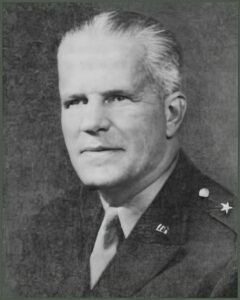Allied Dispositions in the Bullange Sector – December 16, 1944
The Bullange sector was defended by units of V Corps, commanded by Major General Leonard T. Gerow. The frontline positions were held by the 393rd and 394th Infantry Regiments, both part of the 99th Infantry Division.
To the south, in the Lanzerath-Losheim sector, elements of the 14th Cavalry Group, attached to the 1st Infantry Division, were deployed in a screening role.
In Ligneuville, the 49th Anti-Aircraft Artillery Brigade, under the command of Brigadier General Edward J. Timberlake, was deployed in the “Diver Belt” defense system, an anti-V1 configuration (“Diver” being the Allied code for V1 rockets). Its batteries were positioned for air defense and were not integrated into the sector’s ground combat formations (Grégoire, 1986).

Brigadier General Edward “Big Ed” Timberlake was stationed at Hôtel du Moulin, near the northern edge of Ligneuville, along with his staff (Thomas 2012; Wenkin 2024).
In the months leading up to the Battle of the Bulge, the 49th AAA Brigade played a critical role in securing Allied positions across Belgium, Luxembourg, and the Netherlands. Tasked with air defense and tactical support for ground forces, the brigade was responsible for protecting logistical hubs, river crossings, and command installations from aerial attacks, particularly against V-1 flying bombs (Kelakos et al., The Forty-Niners).
Following the rapid Allied advance through France and Belgium, the 49th AAA Brigade relocated its command post to Château de Namur in September 1944, taking control of anti-aircraft defenses along the Meuse River crossings from Dinant to Maastricht. This defensive network ensured the security of supply lines and helped prevent Luftwaffe air raids on critical infrastructure.
The brigade’s firepower was distributed among the 2nd, 11th, 16th, and 18th AAA Groups, which commanded twelve AAA battalions. As the Allied front pushed eastward, the brigade expanded its area of responsibility, securing Luxembourg and Verviers during the autumn of 1944 (Kelakos et al., The Forty-Niners).
Relocation to Ligneuville
By late October 1944, in preparation for further operations, the 49th AAA Brigade moved its command post to Ligneuville, closer to the front lines. The town, historically a hunting retreat, was strategically located near the German border and housed a population with a significant German heritage (Kelakos et al., The Forty-Niners). This repositioning ensured a centralized command structure for anti-aircraft operations in the region.
Throughout November, brigade personnel engaged with both local residents and former Wehrmacht officers, including General von Falkenstein, an associate of Field Marshals von Rundstedt and Model. They also developed contacts within the Belgian resistance (Armée Blanche), forging relationships with key operatives such as an adjutant known as “Nick” (Kelakos et al., The Forty-Niners).
With the increasing threat of V-1 flying bombs, particularly targeting Liège, Verviers, and Spa, the brigade reinforced its “Diver Belt” defense system in November. The 11th AAA Group deployed gun battalions along the front lines, supported by automatic weapons batteries, in an effort to intercept incoming V-1s before they reached Allied-controlled areas (Kelakos et al., The Forty-Niners).
By December, the 49th AAA Brigade’s responsibilities stretched across five countries—France, Holland, Belgium, Luxembourg, and Germany—defending key installations and providing continuous air defense support for advancing Allied forces (Kelakos et al., The Forty-Niners).
While Thanksgiving and Christmas preparations were underway in Ligneuville, reports suggested that both Volksgrenadier divisions and Allied troops were using the sector primarily for training and rotations. The assumption that the terrain’s dense forests and rugged hills made large-scale attacks unlikely led to a false sense of security among American commanders (Kelakos et al., The Forty-Niners).